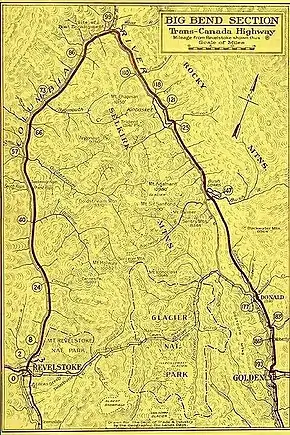Big Bend Highway
The Big Bend Highway is a 305 km (190 mi) former highway in the interior of British Columbia, was the original alignment of British Columbia Highway 1 which followed the Columbia River between Revelstoke and Golden through the Selkirk Mountains.
| Big Bend Highway | |
|---|---|
 | |
| Route information | |
| Length | 305 km[1] (190 mi) |
| Component highways | Highway 1 (1941-1962) |
| Major junctions | |
| West end | Revelstoke |
| East end | Golden |
| Highway system | |
| British Columbia provincial highways | |
History
Big Bend Country was important as it was one of the few land routes possible for a wagon road to connect the Pacific Colony with the rest of British North America. After the gold rush in the late 1860s, travellers used canoes or river steamers until the completion of the Canadian Pacific Railway in the 1880s. In the early 20th century, the Southern Trans-Provincial Highway was the only automobile route which connected southwestern British Columbia with Alberta. The Big Bend Highway, part of the Central Trans-Provincial Highway, was constructed between 1929 and 1940 and was jointly funded by the provincial and federal governments. It was a relief project during the Great Depression and constructed by pick and shovel.[1][2] Initially designated as Route A, it opened on June 29, 1940 and was re-designated as Highway 1 in 1941.[3][4] It was regarded as a perilous gravel road that featured steep grades and runoffs from melting snow in the summer and was closed in the winter, with travellers preferring to use a car shuttle train.[2][4] In 1949, the Trans-Canada Highway Act was passed which allowed construction of the Trans-Canada Highway, and in 1956 the decision was made to reroute the highway between Revelstoke and Donald through Rogers Pass, which officially opened on September 3, 1962; reducing the travel time by approximately 5 hours.[5]
After the rerouting of Highway 1, the western segment of the Big Bend Highway between Revelstoke and Mica Creek became Highway 23 in 1964 and was reconstructed in the late 1960s. In 1973, Mica Dam was completed and sections of the road were flooded by McNaughton Lake (now Kinbasket Lake); other sections were bypassed in the 1980s in anticipation the creation of Revelstoke Lake, which was part of the Revelstoke Dam project. The eastern section of the Big Bend Highway is now a forestry services road and connects with Marl Creek Provincial Park.[4]
References
- "Big Bend Highway". KnowBC - the leading source of BC information. Encyclopedia of BC. Retrieved October 13, 2017.
- Richardson, Mark (2013). Canada's road: A Journey on the Trans-Canada Highway from St. John's to Victoria. Toronto, ON: Dundurn Publications. pp. 132–133. ISBN 978-1459709799.
- Rand McNally and Company (1939). "Western and Central Canada" (Map). "State Farm Road Atlas: United States, Canada, Mexico". Chicago, IL: State Farm Insurance Companies Travel Bureau. pp. 94–95.
- Saunders, J. Clark (2014). Exploring Old Highway No. 1 West: Canada's Route 66. Winnipeg, MB: Heartland Publications. pp. 130–131. ISBN 978-1896150765.
- Francis, Daniel (2012). Road for Canada: The Illustrated Story of the Trans-Canada Highway. North Vancouver, BC: Stanton Atkins & Dosil. pp. 70, 112–118. ISBN 978-0980930405.